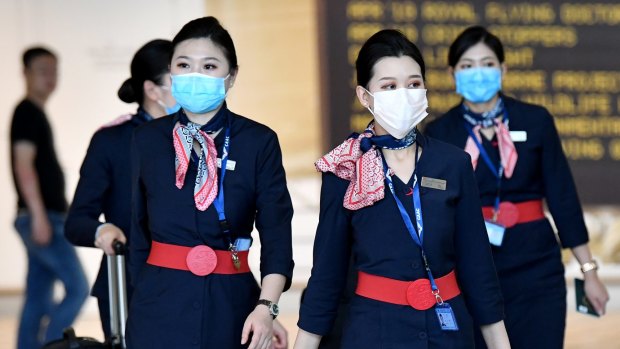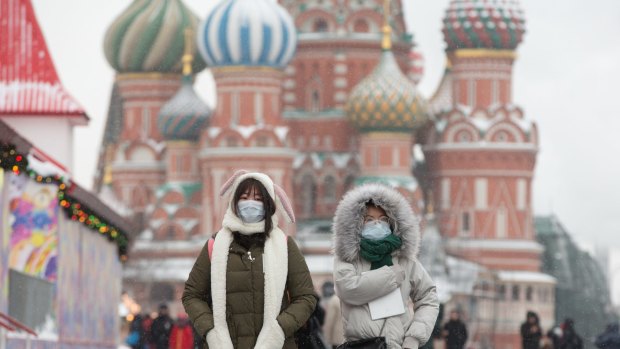This was published 4 years ago
Coronavirus and Chinese tourism: Where the Chinese go on holidays and how this will affect tourism
By Hugh Morris

China Eastern Airlines cabin crew are seen wearing protective face masks at Brisbane International Airport.Credit: Darren England
The unstoppable rise of the Chinese traveller has been well documented.
In 2000 the country's vast population made just 10.5million overseas trips. By 2018 that number had risen to 149.7million, an astounding increase of 1,326 per cent driven by an ever-expanding middle class. By 2030 that number is set rise to an incredible 400 million.
And with more and more holidays comes more and more money; by 2025, Chinese outbound tourism will be worth $US365 billion ($A541 billion).

Tourists wear protective face masks as they walk in Red Square near the Kremlin in Moscow, Russia.Credit: Andrey Rudakov
Such sums explain why the Chinese traveller has become one of the world's most wooed, with tourist boards wide and far falling over themselves to attract a previously untapped market of international visitors.
But the country is now facing total shutdown as the spectre of the coronavirus spreads. The Chinese government has suspended all tour group activities and extended the Chinese New Year holiday period to discourage travel, while the UK Foreign Office has advised against all but essential travel to the country; British Airways, among other airlines, has cancelled its flights.
As well as impacting inbound Chinese tourism, which is likely to slump for the forseeable future, other nations will begin to see consequences.
"I think there are less than half the numbers of last year or the year before," Yoshie Yoneyama, a manager of a shop in the popular tourist resort of Asakusa, Japan, told AFP.
In 2018, 8.4 million Chinese nationals visited Japan, accounting for more than a quarter all tourists; in 2003 the figure was just 450,000.
Japan, like most countries around the world, has set itself ambitious tourism targets to help drive the industry's contribution to GDP. Its aim is to hit 40 million visitors for 2020 (up from 27m in 2018).
Yuki Takashima, an economist at Nomura Securities, says that achievement will now be "very difficult".
Even in the short space of time during which the coronavirus has been an issue - travel restrictions have only been in place for a week or so - more than a handful of destinations have reported falls, including Australia, where 15 per cent of arrivals are Chinese.
In Thailand, where 26 per cent of visitors are from China, helping towards a tourism industry that contributes to 18 per cent of the GDP, the country's tourism minister has already warned that a crisis on the scale of the SARS outbreak in 2003 could cost as much as $1.6bn.
Claude de Crissey, who owns a hotel and restaurant on Phuket, told the AFP the effects were showing.
"For two days, the streets, the shops and the beaches have been deserted," he said. "Phuket has focused almost exclusively on Chinese tourism... if the situation continues, we will all be impacted."
Vietnam and South Korea are both over-exposed, with Chinese travellers making up 31 and 30 per cent of all tourists, respectively.
In Korea, companies that benefit from Chinese tourism saw their stocks tumble more than 10 per cent this week. Japan and Thailand suffered similar slumps. Airlines in the region, including Qantas, Japan Airlines and Cathay Pacific, also experienced dips in their share price.
Europe will likely be slower to feel the pinch, but is not immune from the impact.
Tom Jenkins, CEO of the European Tourism Association (ETOA), said: "However fast the coronavirus is spreading, the impact is spreading faster and wider. Fear, especially combined with government travel bans, is a powerful deterrent to tourism."
He estimated that there had been about 170,000 cancellations in Europe, with 20,000 in the UK, amounting to €340 million of lost revenue, and £35 million in the UK.
He called for calm and said that Europe should expect a post-virus surge as it did after SARS in 2003. "There is no indication that [Chinese tourists] are permanently erasing their intentions to come here," he said.
The UK welcomed nearly 400,000 Chinese tourists in 2018, a record figure, who spent £656m, and has been trying to lure more.
VisitBritain's GREAT China Welcome campaign, for example, was launched in 2014. Hotels, tour operators and attractions were urged to make themselves "China-ready" by providing information in Mandarin or Cantonese and adapting their products for the Chinese market and culture.
In France, the most popular destination in Europe for Chinese visitors, welcoming two million arrivals, head of a travel lobby group has warned of "significant" economic impact if the Chinese are kept home.
Where the Chinese go on holiday
(Percentage of inbound visitors (2018) who are Chinese nationals)
1. Vietnam: 31.61 per cent
2. South Korea: 30.61 per cent
3. Japan: 26.93 per cent
4. Thailand: 26.12 per cent
5. Singapore: 23.31 per cent
6. Taiwan: 24.3 per cent
7. Australia: 15.45 per cent
8. New Zealand: 12.19 per cent
9. Malaysia: 11.22 per cent
10. US: 3.76 per cent
11. Canada: 3.48 per cent
12. UK: 1.07 per cent
The Telegraph, London
Sign up for the Traveller newsletter
The latest travel news, tips and inspiration delivered to your inbox. Sign up now.